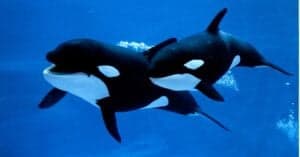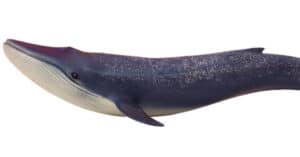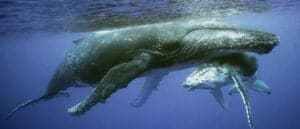How do Whales Mate and Reproduce?
Humpback whales have a reputation for singing elaborate love songs during mating season. Both males and females can makes sounds but only the males create long songs that can last a few minutes to more than a half-hour. Scientists that have studied the songs have found that they change each season, almost like the whales have been composing new songs all year and can’t wait for the new release. What is amazing is that large groups of male whales will band together and sing the same song together! How can female whales resist the appeal of a boy band? Let’s take a look at how whales mate and reproduce to carry on their enormous legacy.
How do whales mate?
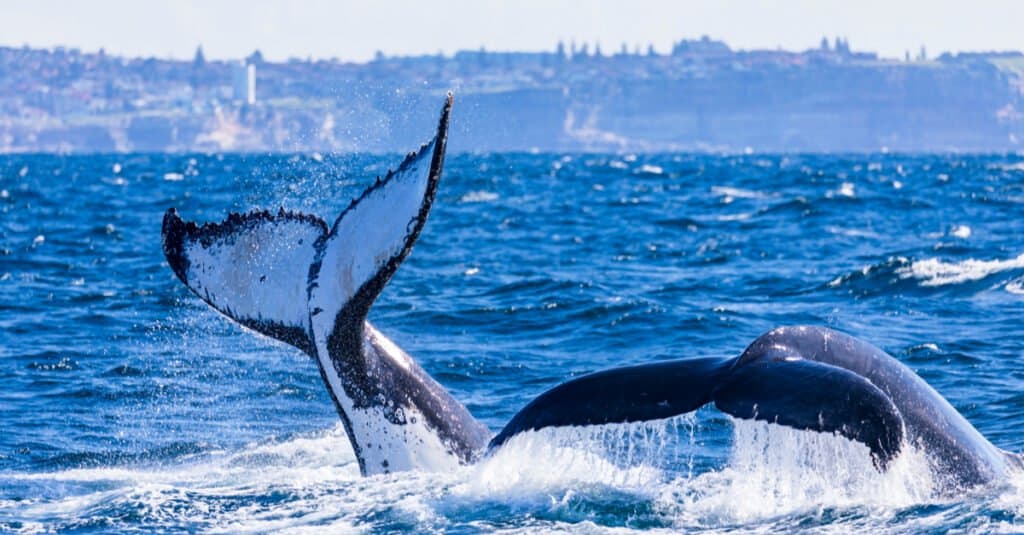
Wongymark1/Shutterstock.com
Mating in water has its challenges! For example, in water there’s nothing solid to lay on or lean against. Also, whales and dolphins need to breath every 3 to 15 minutes. Anything but a speedy mating process would leave whales with a need to reach the surface for a breath of air! As we’ll describe below, different whale species have their own courtship and pre-mating rituals.
How do humpback whales mate and reproduce?
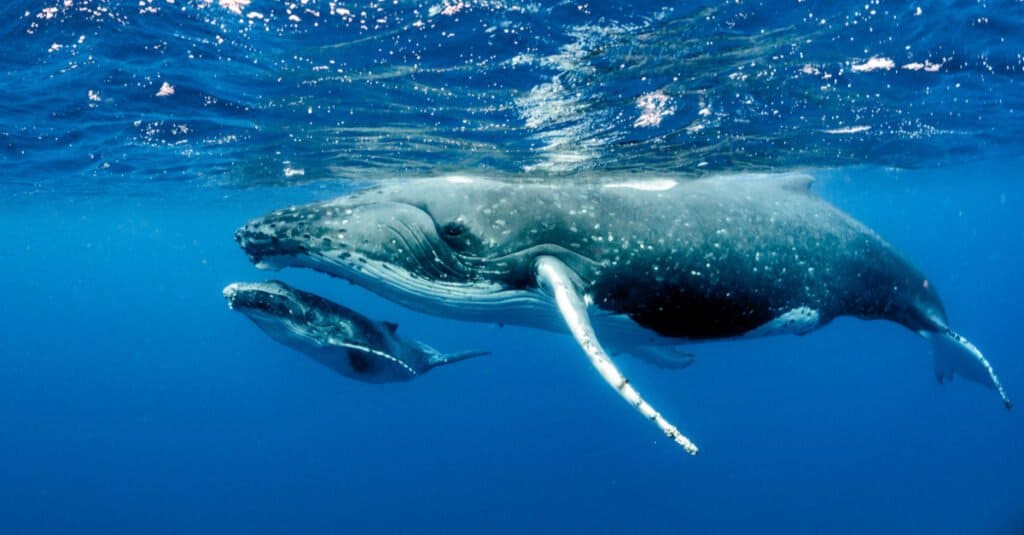
Humpback whales migrate during breeding and birthing season, making an incredible trip of 5,000+ miles. The northern Pacific humpback, for example spends its summers in the waters around Northern California, Northern Japan and in the Bering Sea. During mating season they will make the trek down to four different breeding grounds; Hawaii, Islands south of Japan, Mexico and Central America. They travel down in pods, some in small pods of 2-3 and others in larger pods, and there are some that make the trek on their own. Off the coast of Hawaii there is a group of 5,000 or more humpback whales that gather every year between December and May, where they form competition pods for mating.
What is a competition pod?
Once in the breeding grounds the whales form competition pods. One female whale is typically paired with a primary escort (male) and a group of males will try to fight for their right to overthrow the escort and earn mating rights. A competition pod can have just a handful of whales or a larger group of 12-15. The whales will bump heads, slap tails and splash their fins to attract the attention of the female. The female may also take off on a high speed game of chase and the males will follow her in pursuit. Some whales may give up and take off from the competition pod while others may join in to see if they have what it takes. Ultimately one male wins the mating rights and the female and male may dive down and back up together. Whales fertilize internally so the male will deposit his sperm in the female fertilizing one egg. The females will carry the singleton baby for almost a full year with the gestation lasting 11 months. Whales are not monogamous and males and females do not form tight bonds after mating.
What do we know about baby humpback whales?
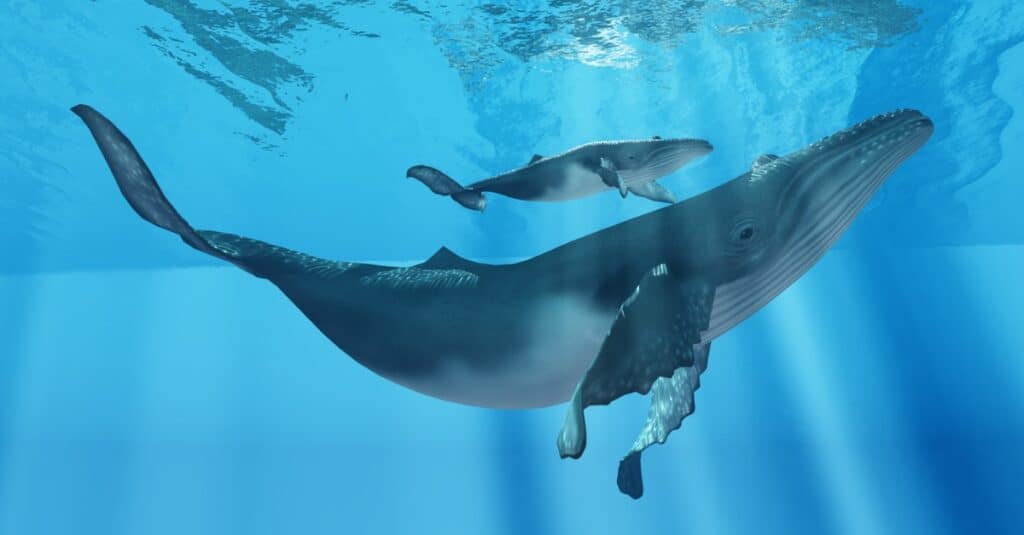
iStock.com/CoreyFord
About a year later the female whale will return to the migration area to birth their calves. Whales are mammals so they give birth to live young and the babies nurse from their mother’s milk. Baby humpback whales can be 12-16 feet long. Think about how a baby whale may look awkward learning to use its fins and tail for the first time! They will stay quite close to their mothers for about a year before venturing away. Mothers and calves migrate together with the mother teaching her young the route so that they will know the way when they get older. When male whales get a bit older they will learn the song-singing tradition by singing along with the older experienced males.
How do blue whales mate and reproduce?

Andrew Sutton/Shutterstock.com
Blue whales, the largest species of whales and the largest animal, are difficult to track and study so the information we have on them is still evolving. We have found that some migrate to breeding grounds seasonally while others appear to be more residential. The presence of krill, their main food source, seems to be the bigger factor in where the whales are located. Blue whales are more solitary and spend most of their time alone with the exception of breeding season. During the courting period male whales may participate in what is called a “heat run” where two males race after a female in hot pursuit. Blue whales and humpback whales have the same internal fertilization and the males will fertilize the females. We don’t know much about the reproduction cycle of blue whales but scientists estimate that the gestation period is 10-12 months with the female returning to the breeding grounds to also give birth.
What do we know about baby blue whales?
Since blue whales are the biggest animal you would think they have the biggest babies and you would be right. A baby blue whale can weigh up to 6,000 lbs at birth! At that size it comes as no surprise that the mother only has one baby at a time. All whales are mammals so the baby will nuzzle at her mother for milk early on and for the next six to eight months, once weaned they still stay with their mothers for a couple of years before venturing out on their own.
How do dolphins mate and reproduce?

iStock.com/NaluPhoto
Dolphins are a kind of whale and have been studied extensively in the wild and in captivity. Dolphins are playful animals and researchers have years of data and observations on their mating and reproductive behaviors. Female dolphins reach sexual maturity between 7-12 years old and males a little later between 10-15 year old. Because dolphins prefer warm waters they do migrate to warmer waters seasonally, but it is different than a migration for breeding purposes due to the fact that dolphins can mate year round.
When they do mate the male can be observed swimming around, s-posturing (with their nose up, fins down, back up and tail down, curving their body in the shape of an “s”) and vocalizing. The male and female may chase each other around and playfully rake their teeth on each other. One of the pair may seem to go limp and lay on their side, while the male approaches to mate and deposit his sperm into the female for fertilization. The male dolphin does not stick around, they are not monogamous and do not mate for life. The female will carry the baby for about 12 months. Dolphins only carry one baby at a time.
What do we know about baby dolphins?
After a 12 month gestation the baby dolphin will be delivered live. Baby dolphins are born tail first and their dorsal fin is folded over until after they are born. They are 40-50 inches long and can weigh between 20-40lbs. Their skin color is darker than the adults and appears to have stripes but these will fade and their coloration will change to a light gray (for most species). Female dolphins have been witnessed assisting the new mother during birth and the females in the pods will help care for the young with the mother.
The male dolphins do not assist in calve care and tend to form pods with other males. Dolphins are mammals and their young will nurse their mother’s milk for 2-4 years and stay with their mothers for 3-6 years. When dolphins leave their mothers they tend to team up and form pods with like aged dolphins forming juvenile pods. Young dolphins seem to like to play with each other and may play tag with seaweed or catch with a puffer fish. A BBC Earth video shows dolphins playing catch with a puffer fish underwater!
More from A-Z Animals
Humpback whales have a reputation for singing elaborate love songs during mating season. Both males and females can makes sounds but only the males create long songs that can last a few minutes to more than a half-hour. Scientists that have studied the songs have found that they change each season, almost like the whales have been composing new songs all year and can’t wait for the new release. What is amazing is that large groups of male whales will band together and sing the same song together! How can female whales resist the appeal of a boy band? Let’s take a look at how whales mate and reproduce to carry on their enormous legacy.
How do whales mate?

Wongymark1/Shutterstock.com
Mating in water has its challenges! For example, in water there’s nothing solid to lay on or lean against. Also, whales and dolphins need to breath every 3 to 15 minutes. Anything but a speedy mating process would leave whales with a need to reach the surface for a breath of air! As we’ll describe below, different whale species have their own courtship and pre-mating rituals.
How do humpback whales mate and reproduce?

Humpback whales migrate during breeding and birthing season, making an incredible trip of 5,000+ miles. The northern Pacific humpback, for example spends its summers in the waters around Northern California, Northern Japan and in the Bering Sea. During mating season they will make the trek down to four different breeding grounds; Hawaii, Islands south of Japan, Mexico and Central America. They travel down in pods, some in small pods of 2-3 and others in larger pods, and there are some that make the trek on their own. Off the coast of Hawaii there is a group of 5,000 or more humpback whales that gather every year between December and May, where they form competition pods for mating.
What is a competition pod?
Once in the breeding grounds the whales form competition pods. One female whale is typically paired with a primary escort (male) and a group of males will try to fight for their right to overthrow the escort and earn mating rights. A competition pod can have just a handful of whales or a larger group of 12-15. The whales will bump heads, slap tails and splash their fins to attract the attention of the female. The female may also take off on a high speed game of chase and the males will follow her in pursuit. Some whales may give up and take off from the competition pod while others may join in to see if they have what it takes. Ultimately one male wins the mating rights and the female and male may dive down and back up together. Whales fertilize internally so the male will deposit his sperm in the female fertilizing one egg. The females will carry the singleton baby for almost a full year with the gestation lasting 11 months. Whales are not monogamous and males and females do not form tight bonds after mating.
What do we know about baby humpback whales?

iStock.com/CoreyFord
About a year later the female whale will return to the migration area to birth their calves. Whales are mammals so they give birth to live young and the babies nurse from their mother’s milk. Baby humpback whales can be 12-16 feet long. Think about how a baby whale may look awkward learning to use its fins and tail for the first time! They will stay quite close to their mothers for about a year before venturing away. Mothers and calves migrate together with the mother teaching her young the route so that they will know the way when they get older. When male whales get a bit older they will learn the song-singing tradition by singing along with the older experienced males.
How do blue whales mate and reproduce?

Andrew Sutton/Shutterstock.com
Blue whales, the largest species of whales and the largest animal, are difficult to track and study so the information we have on them is still evolving. We have found that some migrate to breeding grounds seasonally while others appear to be more residential. The presence of krill, their main food source, seems to be the bigger factor in where the whales are located. Blue whales are more solitary and spend most of their time alone with the exception of breeding season. During the courting period male whales may participate in what is called a “heat run” where two males race after a female in hot pursuit. Blue whales and humpback whales have the same internal fertilization and the males will fertilize the females. We don’t know much about the reproduction cycle of blue whales but scientists estimate that the gestation period is 10-12 months with the female returning to the breeding grounds to also give birth.
What do we know about baby blue whales?
Since blue whales are the biggest animal you would think they have the biggest babies and you would be right. A baby blue whale can weigh up to 6,000 lbs at birth! At that size it comes as no surprise that the mother only has one baby at a time. All whales are mammals so the baby will nuzzle at her mother for milk early on and for the next six to eight months, once weaned they still stay with their mothers for a couple of years before venturing out on their own.
How do dolphins mate and reproduce?

iStock.com/NaluPhoto
Dolphins are a kind of whale and have been studied extensively in the wild and in captivity. Dolphins are playful animals and researchers have years of data and observations on their mating and reproductive behaviors. Female dolphins reach sexual maturity between 7-12 years old and males a little later between 10-15 year old. Because dolphins prefer warm waters they do migrate to warmer waters seasonally, but it is different than a migration for breeding purposes due to the fact that dolphins can mate year round.
When they do mate the male can be observed swimming around, s-posturing (with their nose up, fins down, back up and tail down, curving their body in the shape of an “s”) and vocalizing. The male and female may chase each other around and playfully rake their teeth on each other. One of the pair may seem to go limp and lay on their side, while the male approaches to mate and deposit his sperm into the female for fertilization. The male dolphin does not stick around, they are not monogamous and do not mate for life. The female will carry the baby for about 12 months. Dolphins only carry one baby at a time.
What do we know about baby dolphins?
After a 12 month gestation the baby dolphin will be delivered live. Baby dolphins are born tail first and their dorsal fin is folded over until after they are born. They are 40-50 inches long and can weigh between 20-40lbs. Their skin color is darker than the adults and appears to have stripes but these will fade and their coloration will change to a light gray (for most species). Female dolphins have been witnessed assisting the new mother during birth and the females in the pods will help care for the young with the mother.
The male dolphins do not assist in calve care and tend to form pods with other males. Dolphins are mammals and their young will nurse their mother’s milk for 2-4 years and stay with their mothers for 3-6 years. When dolphins leave their mothers they tend to team up and form pods with like aged dolphins forming juvenile pods. Young dolphins seem to like to play with each other and may play tag with seaweed or catch with a puffer fish. A BBC Earth video shows dolphins playing catch with a puffer fish underwater!


